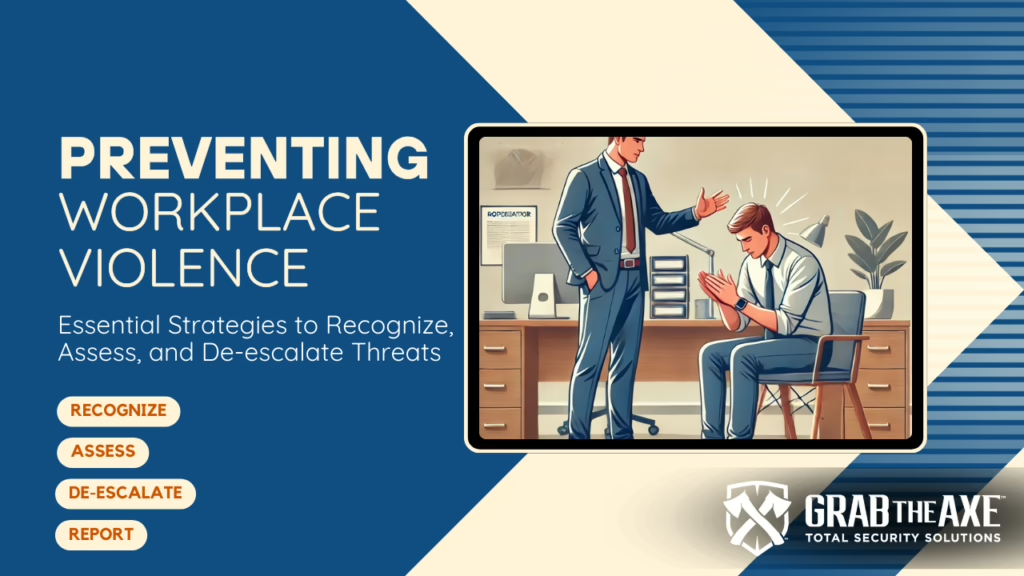In a time where physical and digital security are inseparable, creating a safer workplace isn’t just about installing cameras or firewalls—it’s about people. Recognizing potential risks, knowing when and how to act, and understanding your role in violence prevention can mean the difference between calm and crisis.
Your peace of mind is our mission, and this guide will help demystify the process of managing potentially dangerous situations.
1. Recognize Early Signs: Key Steps to Preventing Workplace Violence
Recognition is the cornerstone of violence prevention. Identifying early warning signs empowers individuals and organizations to intervene before behaviors escalate.
Key Focus Areas:
- Stressors – Situations causing significant strain or tension:
- Financial problems
- Relationship breakdowns
- Health issues, addiction, or grief
- Employment-related struggles, such as demotion or termination
- Legal troubles and relocations
“People are unique, and their stressors may manifest in unpredictable ways.” – Recognize Guide
Learn how to recognize and address aggressive behavior to stop potential threats early.
- Changes in Baseline Behavior – Notice shifts from an individual’s normal personality or actions:
- A previously outgoing person becomes withdrawn.
- A typically calm individual exhibits unusual irritability or anger.
- Increased absenteeism, performance decline, or lack of focus at work.
- Behavioral Indicators:
- Familiar Individuals: Increased hostility, inappropriate statements, threats, fascination with violence, or new interest in weapons.
- Unfamiliar Individuals: Visible agitation (clenched fists, pacing), threatening comments, personal space violations, or trembling.
Immediate Action: Document concerning behaviors and communicate observations to supervisors or security personnel.
Recognize aggressive body language cues to take proactive steps in de-escalating tense situations.
2. Assess Workplace Risks: Preventing Workplace Violence Through Evaluation
Once behaviors are recognized, assessing the severity of the situation determines the appropriate next steps. This involves evaluating risks based on observed behaviors, context, and intent.
Key Steps in Risk Assessment:
- Ask Key Questions:
- What behaviors have caused concern?
- Is there an immediate or imminent threat?
- Are stressors or environmental factors contributing to the situation?
“Threat assessment asks key questions: Does the individual pose a threat? Is the person moving toward committing a malicious act?” – Assess Guide
- Types of Assessments:
- Informal Assessment:
Use observations and small, low-risk interactions like the “Power of Hello” to gauge intent. This can help de-escalate minor situations early. - Formal Threat Assessment:
A multidisciplinary threat assessment team conducts a structured analysis, gathering information about:- Stressors impacting the individual
- Evidence of planning violent acts
- Behavioral consistency with perceived threats
- Informal Assessment:
- Early Warning Signs of Escalation:
- Uncontrolled pacing or gestures
- Heightened physical responses: clenched fists, raised voice, rapid breathing
- Personal space violations or agitation in restricted areas
“Trust your instincts. If a situation feels beyond your control, seek help.” – Assess Guide
Learn how to identify individuals who may pose a threat and enhance your workplace safety protocols.
3. De-escalate Conflict: Techniques for Preventing Workplace Violence
De-escalation is the skillful use of purposeful actions, communication, and body language to diffuse tension and reduce the risk of violence.
Purposeful Actions:
- Remain Calm: Control your breathing and keep a composed demeanor.
- Change the Setting: If safe, move the conversation to a quieter, less crowded space.
- Respect Personal Space: Maintain a safe physical distance.
- Actively Listen: Give full attention, nod to show understanding, and avoid interrupting.
- Show Empathy: Use phrases like, “I understand this is frustrating. How can I help?”
Verbal Communication:
- Tone: Use a calm, low, and steady tone of voice.
- Volume: Avoid raising your voice.
- Rate of Speech: Speak slowly and deliberately.
- Choice of Words: Avoid triggering phrases like “Calm down” or “I can’t help you.” Instead, say:
- “I can see you’re upset. Let’s work through this together.”
- “I want to help. What can I do right now to make this better?”
Body Language:
- Keep your stance relaxed but alert, positioning yourself slightly to the side of the individual.
- Keep your hands visible and move slowly.
- Use a neutral facial expression to avoid signaling aggression.
“De-escalation relies on purposeful actions and body language to calm potentially violent situations.” – De-escalation Guide
Safety Reminder: If de-escalation fails or the risk increases, prioritize your safety and seek immediate help.
4. Report Threats: Critical Steps for Preventing Workplace Violence
Reporting is critical to mitigating risks, preventing escalation, and protecting both individuals and communities. It creates opportunities for early intervention and professional support.
When to Report:
- Immediate Threat: If violence seems imminent or weapons are involved, call 9-1-1 and move to safety.
- Organizational Reporting: For non-urgent concerns, follow your organization’s reporting protocols.
Key Details to Include in a Report:
- Behavioral Observations:
- Specific comments, threats, or actions observed.
- Context surrounding the incident.
- Stressors: Known personal or professional issues that may contribute to the behavior.
- Evidence of Planning:
- Expressions of intent to harm others.
- Attempts to bypass security systems.
“Reporting is not punitive. It’s about helping the individual and ensuring safety for all.” – Report Guide
Overcoming Reporting Barriers:
- Some may hesitate to report due to fear of “getting it wrong” or “causing harm.” Organizations must foster a culture of shared responsibility and ensure reporting systems are supportive, not punitive.
Key Takeaway: Early reporting allows threat assessment teams to evaluate risks and intervene before escalation occurs.
The Importance of Preventing Workplace Violence
By following the four steps—Recognize, Assess, De-escalate, and Report—individuals and organizations can play an active role in violence prevention. Building a safer workplace starts with awareness and action.
Strengthen workplace security with essential safety strategies designed to protect employees
At Grab The Axe, we believe “Security is not one-size-fits-all; it is as unique as you are.” Whether you’re tackling physical or digital risks, we stand ready to help you face modern threats with confidence.
References
Cybersecurity and Infrastructure Security Agency (CISA). (2024). De-escalation products and resources. https://www.cisa.gov/de-escalation-products-and-resources
Preventing Workplace Violence FAQ:
What are the early warning signs of preventing workplace violence?
Early warning signs include changes in baseline behavior, such as a typically calm individual becoming agitated, unusual absenteeism, and performance decline. Physical signs include pacing, agitated gestures, blocking movement, or inappropriate responses to stress.
How do I assess a situation for potential workplace violence?
Trust your instincts and evaluate both the individual and the environment. Look for behavioral indicators, assess distractions, and note whether the person seems agitated, nervous, or threatening. If you feel unsafe, seek immediate assistance.
What are effective de-escalation techniques to prevent workplace violence?
- Actions: Remain calm, respect personal space, and actively listen.
- Verbal: Speak with empathy and in a calm tone, avoid raising your voice.
- Body Language: Maintain a relaxed posture, move slowly, and keep hands visible.
What is the "Power of Hello," and how does it help prevent workplace violence?
The “Power of Hello” is a simple greeting technique used to assess individuals with unknown intentions. Observe their response—nervousness, avoidance, or aggressive postures could indicate a potential threat.
When should I contact security or law enforcement in a workplace violence situation?
Immediately involve law enforcement or security personnel if there is a sense of imminent danger, physical aggression, threats, or the display of a weapon. Your safety is the top priority.
How do I report concerning behaviors to help prevent workplace violence?
-
Provide specific details, including:
- The behavior you observed (actions or threats).
- Who was involved and if there was an intended target.
- Known stressors or relevant background.
For immediate concerns, call 9-1-1. For non-urgent cases, follow your organization’s reporting process.
-
Why is reporting concerning behavior critical to preventing workplace violence?
Reporting creates opportunities for early intervention and support for the individual of concern. It allows threat assessment teams to analyze risks and implement proactive measures to prevent escalation.
What is the role of a formal threat assessment in preventing workplace violence?
A formal threat assessment gathers and analyzes information about individuals who may pose risks. Conducted by a multidisciplinary team, it identifies the severity of threats and determines appropriate interventions to prevent violence.
What role do stressors play in escalating workplace violence?
Stressors like financial issues, relationship breakdowns, or employment struggles can lead individuals to act unpredictably. Recognizing stressors and providing support can help mitigate potential risks of violence.
Where can I find professional guidance on preventing workplace violence?
For tailored strategies and expert support in workplace violence prevention, contact Grab The Axe today. Our specialists can help you build a safer workplace.





